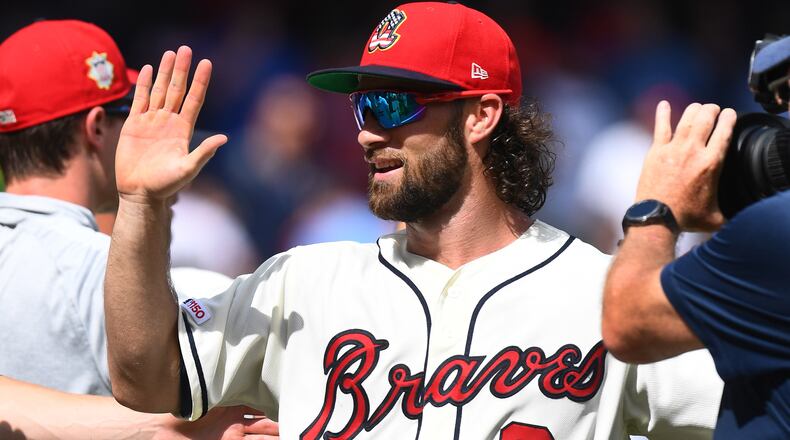After winning the National League East by eight games last season, the Atlanta Braves lead by six games at the All-Star break. They have the NL's second-best record since Opening Day 2018. If you wondered whether they were a one-hit wonder, there's your answer. They've gone from strength to strength. They're bona fide.
Not everything has gone right this season. Three of the five pitchers ticketed for their rotation no longer take regular big-league turns. Their presumptive closer no longer works here. One of their starting outfielders hasn’t played since May 14. And yet: At the break last summer, the Braves were 54-44, a half-game behind Philadelphia; they’re 54-37 now, comfortably atop what was billed as a beefier division.
They lead the league in runs. They lead in bullpen ERA. (This despite having blown the fourth-most saves among NL clubs.) Their cobbled-together rotation remains a warning flare, but no organization has more in-house options. If the playoffs began today — pretty sure they won’t — the Braves wouldn’t be the first choice to represent the National League in the World Series. But they’d be second or third, depending on your view of the Cubs, and here we again do the macro thing.
Braves stat leaders
In October 2017, the Cubs were the defending World Series champs. They met the Dodgers, who'd won 104 games, in the NLCS. That was the month that saw John Coppolella, the general manager who'd overseen the Braves' manic rebuild, resign as a consequence of MLB's investigation into misdeeds in the international talent market. Coppolella would subsequently be banned for life; the Braves would forfeit 13 prospects.
In October 2017, the Braves were 72-90, coming off a fourth consecutive losing season. Much of that losing had been on purpose, but still. Even if you believed in the tear-down-to-build-back course taken by Coppolella and John Hart at the behest of franchise patriarch John Schuerholz, you couldn’t have known how soon the build-back part would coalesce, if indeed it ever would.
Alex Anthopoulos was named Braves GM in November 2017. He made his first major trade the next month, and it was in keeping with many of the deals made under previous management. It was a two-way salary dump, the Braves sending Matt Kemp — whom Coppolella had landed mostly to offset the money owed to Hector Olivera, who to this day has taken 98 big-league at-bats — to the Dodgers for Adrian Gonzalez, Scott Kazmir, Brandon McCarthy and Charlie Culberson. Gonzalez and Kazmir never played for the Braves. McCarthy made it through one season. Culberson remains a useful utility.
That was how Anthopoulos’ stewardship began. It was also the last major trade of its sort he has made. By May 1, 2018 — the day of Mike Soroka’s big-league debut — the new GM had taken the measure of his new club, and he’d said, in effect, “By golly, we can win.” By golly, they have.
This year the Braves — pilloried in many sectors for never spending a dime — have bought a former MVP for $23 million and a former Cy Young winner for $13 million. They're in first place. The Phillies spent $330 million on Bryce Harper, the Padres $300 million on Manny Machado; those teams are a collective four games above .500. Anthopoulos has taken what he'd inherited and, for the most part, has been happy to let the interest compound, as it were. At the trade deadline last year, a high-profile pitching rental was offered for one of the Braves' top prospects. The Braves said no. That prospect is now among the big-league team's brightest lights.
The Braves are good again: That’s the new normal, and it’s not apt to change anytime soon.
Let’s say the Braves let Josh Donaldson, who has been pretty darn good, leave as a free agent after this season. Let’s say Austin Riley moves from left field to third base, his natural position. Let’s say the club doesn’t exercise its option on Nick Markakis, opening another outfield spot. Let’s say Inciarte takes left field — big if, I know; he hasn’t hit much for a while — and Cristian Pache, the 20-year-old now in Double-A, takes the other.
Here would be the Opening Day 2020 ages of the Braves’ position players, catcher excluded: Freddie Freeman, 30; Ozzie Albies, 23; Dansby Swanson, 26; Riley, 22; Inciarte, 29; Ronald Acuna, 22, and Pache, 21. (Yes, the Braves will soon need to replace the catching tandem of Tyler Flowers/Brian McCann. That’s why they took Shea Langeliers with the ninth overall pick in June.) For all the issues with this rotation, we note that, of the 10 starting pitchers the Braves have used, only four turns have been taken by someone over 28. Those four have fallen to Keuchel, who’s on a one-year deal.
If the Braves do nothing — and buying an MVP and a Cy Young pitcher suggests Anthopoulos isn’t about to do nothing — they should be very good for a good long while. That’s because the hidden part of the rebuild has likewise been accomplished. The Braves are done with salary dumps. No terrible contracts hang overhead. (Inciarte is owed $15.4 million over the next two seasons, but that’s not terrible.)
There are no terrifying free agencies on the horizon. Freeman is under contract through 2021, Albies through 2027, Acuna through 2028. The belief is that this year's budget for payroll increased to $140 million after last season's $120 mil, and that's apt to keep rising — not into Yankees/Dodgers territory, no, but rising still.
They’re a winning team in a 2-1/2-year-old ballpark. They’re ridiculously young. They have a canny GM who, having won elsewhere, knows what winning entails. They might not win the World Series this year — then again, the MLB playoffs have taught us that if you get in, you can win — but they should keep getting that chance. They’re in a great place.
Division standings
About the Author
The Latest
Featured



